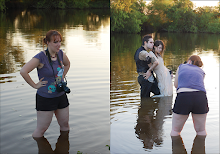
Chapter 4: Working with Selections
In this chapter, we edited a photograph of several vegetables, a cutting board and an advertisement stick utilizing the different selection tool available.
To start, we used the magic wand tool to select the tomato. The magic wand tool is best for selecting parts of images that have solid or mostly solid colors. So, for the tomato, all we had to do was click once on the red and once on the green of the leaves. We then moved it to the bottom left corner of the cutting board and saved.
The second image selected was the lettuce. We again used the magic wand tool, buy this time we used the rectangular Marquee tool to zoom in on the lettuce, selected magic wand tool with the minus sign and clicked the white of the background which in turn selected everything but the white. This is good because the lettuce has many variations of greens.
The third image was a set olives that had an oval color surrounding it. For this we chose the eliptical marquee tool to draw around the oval. To do this you would start by creating a rough outline by dragging the mouse around the oval. Chances are you won't get it perfect with just that, so without letting go of the mouse you would additionally click on the space bar to add more adjustment. Releasing the space bar allows you to move the oval, but you can't stop depressing the mouse until the oval is lined up just the way you want.
We then added the Salads advertisement buttom. We selected the button with the elliptical marquee tool then dragged it to where we wanted it. Instead of stopping there, we added two more of the same button except larger each time. To duplicate the button you would select the Move tool, hold down Alt as you position the pointer inside the graphic. Continue holding down Alt and drag the duplicate down to the right. To make the selection larger, however, you would choose Edit > Transform > Scale then adjust from there.
Our next vegetable was the carrot which we zoomed in on to fill the screen. We started to highlight the curved part of the carrot with the lasso tool which is completely freehand, but changed to the polygonal lasso tool which creates anchor points each time you click. To switch from lasso to polygonal you would hold down Alt and then release the mouse button. We then dragged the carrot to the center of the cutting board, but chose to rotate it to better fit the composition by choosing Edit > Transform > Rotate.
Finally, we used the magnetic lasso tool which is fairly automatic and works well for solid colored images.
The "complicated" part of this lesson was in creating the seperate layers so that we can go back and edit individual parts of the composition. To do this, you would choose the quick selection tool to highlight each individual vegetable then click Edit > Copy > Edit > Paste. Once you have the new layer you can refine the edges to give a more realistic feel to it. In the tool options bar you would click refine edges, create a soft edge for teh shadows, edter a feather value of 7 pixels and expand value to 5%. By clicking the Black Matte button the background becomes black and by increating the Expand value the shadow increases.
You would essentially create a new layer for each vegetable and drag the edits you did on the first veggie to the layer of the next veggie to apply the same shadow and blur to the edges.
To view notes on the last part of the blog notes, look back on pages 126-135.

No comments:
Post a Comment